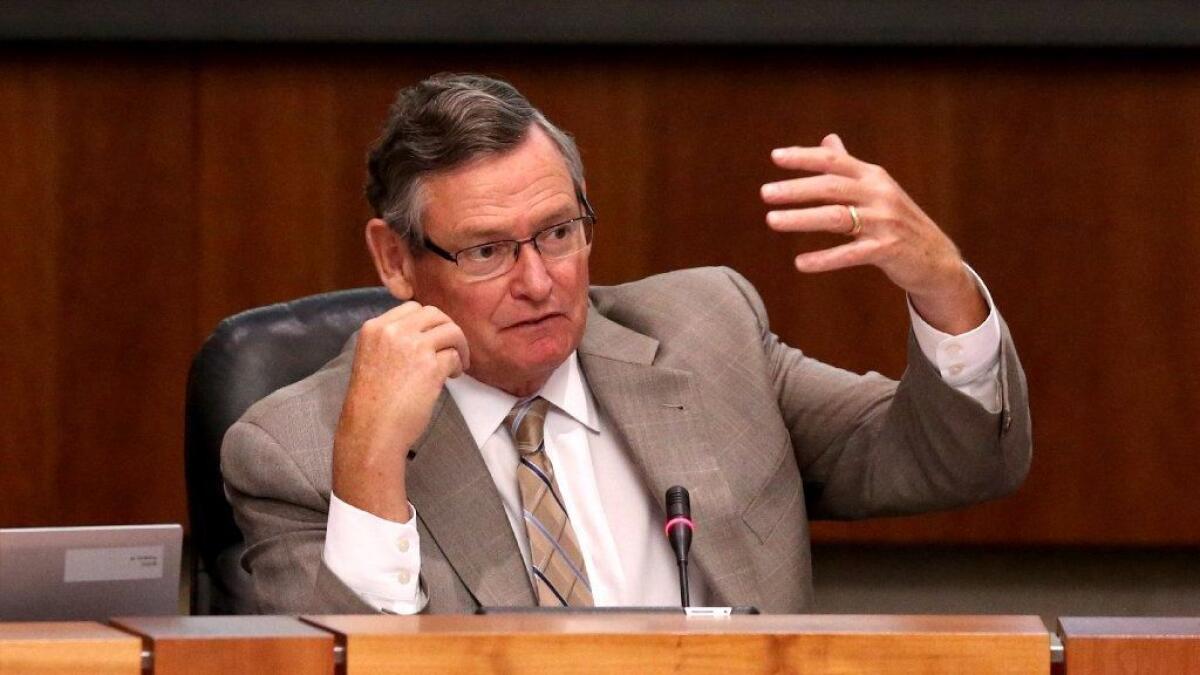Cal State trustees to discuss Brown’s latest budget proposal, which they say still falls $171 million short

- Share via
Just how much money does California State University need to serve its students?
In recent years, this question has been front and center for the nation’s largest public university system.
Cal State’s leaders say that to keep their campuses’ quality from slipping, they need much more money than the state is giving them. This year, they’re also at odds with Gov. Jerry Brown on the question of whether any extra money should come in one-time bursts or be ongoing.
The public university system’s budget will be a major topic for Cal State’s trustees this week when they meet at the chancellor’s office in Long Beach.
Brown’s initial budget proposal included a $92-million increase for Cal State, $171 million below what trustees asked for. The governor didn’t increase that number in his revised budget, released Friday.
He did, however, propose a one-time allocation of $100 million to go toward Cal State’s long-deferred facilities maintenance.
Chancellor Timothy P. White argues that the overall outlay is not enough, especially given the state’s $8.8-billion projected surplus — most of which Brown wants the state to save to be prepared for the next downturn.
“Without sufficient funding from the state, the university will face adverse consequences including the slowing of recent advances in student achievement,” White said in a statement Friday.
Cal State has absorbed many students since the recession, when California slashed nearly one-third of its support. And while funding has been gradually restored in recent years, university administrators say, it hasn’t kept up with current needs.
The system had asked the governor for $15 million a year specifically to pay for deferred maintenance — with the rest of the state funding to go toward such priorities as hiring more staff to serve the growing student body and working to boost graduation rates.
Overall, Cal State calculates that it has a $2-billion maintenance backlog. Top priorities on a long list include retrofitting Cal State LA’s administration building for earthquake protection and replacing a science building in San Francisco.
The system also is under pressure to accommodate more students, and officials say they need more funding to be able to do so. Last fall, about 32,000 eligible applicants were turned away because of overbooked programs and classes.
Earlier this year, trustees were considering a tuition hike — which would have been the second one in a row after a six-year freeze.
In April, White shelved the increase, arguing that the economy was strong enough now that students should not be asked to increase their financial burdens. The hope was that Sacramento would come through with more money.
”It’s the right thing to do, but it’s not without risk,” White said when he announced the gambit.
Brown has repeatedly voiced his thinking that Cal State and the University of California should learn to live within their means rather than keep demanding more money.
In the explanation of his revised budget, the governor noted that a tuition hike would increase the amount of money the state would have to pay for the Cal Grant and Middle Class Scholarship financial aid programs. He proposed updating budget language so that if Cal State — or the University of California — does raise tuition, the state will be able to take the extra money it has to spend out of the money it has earmarked for the public university system. (Cal State officials said Monday there’s no chance the system will raise tuition this year.)
The final budget is due in June. Until then, White said, the trustees will continue to push for more funding in Sacramento.
He has the support of Assembly Speaker Anthony Rendon (D-Paramount), who released a statement saying that the Assembly has listened — and heard — as students, faculty and staff at Cal State and the University of California have “made the case for funding to stabilize tuition rates, address rising costs, and enroll more California students.”
White said in an April interview that inadequate additional funding could force him to make cuts in the chancellor’s office and enroll fewer students. It could also mean fewer course options for those students who did enroll.
More to Read
Sign up for Essential California
The most important California stories and recommendations in your inbox every morning.
You may occasionally receive promotional content from the Los Angeles Times.











